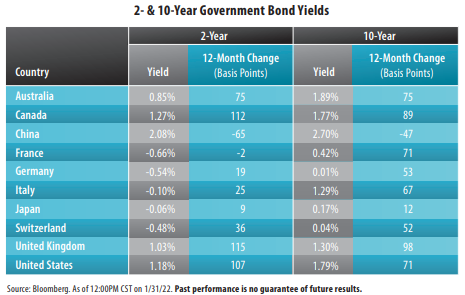
View from the Observation Deck
1. Today's blog post shows the yields on a couple of benchmark government bond maturities from key countries/economies around the globe.
2. While bond yields are up from their historic lows, in most instances, they remain artificially depressed.
3. The yield on the U.S. 10-year Treasury Note (T-note) stood at 1.79% as of 12:00PM CST on 1/31/22, 128 basis points (bps) higher than its all-time closing low of
0.51% on 8/4/20 (not in table), but 223 basis points below its 4.02% average yield for the 30-year period ended 1/28/22 (not in table), according to Bloomberg.
4. The yield spread between the U.S. 2-year T-note and the 10-year T-note was 61 basis points as of 12:00PM CST on 1/31/22, well below its 30-year average spread of
116 basis points as of 1/28/22, according to Bloomberg.
5. Federal Reserve ("Fed") Chairman Jerome Powell sees the Fed ending its monthly bond buying program by March 2022, according to The Wall Street Journal. At
some point that could lead to a modest paring down of the assets it holds on its balance sheet, which stood at $8.86 trillion on 1/26/22, according to Bloomberg.
The Fed also estimates that it could initiate three interest rate hikes in 2022, though such a forecast is always subject to change.
6. Investors continue to funnel huge amounts of capital into U.S. government bond mutual funds and exchange-traded funds (ETFs) despite the rise in bond yields.
Long Government, Intermediate Government and Short Government bond mutual funds and ETFs reported estimated net inflows totaling $23.26 billion, $10.93
billion and $4.45 billion, respectively, in 2021, according to Morningstar.
7. With the rise in government bond yields throughout much of the globe over the past year, the amount of negative-yielding debt has declined significantly, as
measured by the Bloomberg Global Aggregate Negative Yielding Debt Index. The total value stood at $8.94 trillion on 1/28/22, down from $17.20 trillion a year ago.
8. We will continue to monitor to see if rising inflation plus the potential for tapering by year-end is enough to push bond yields higher in the months ahead.



